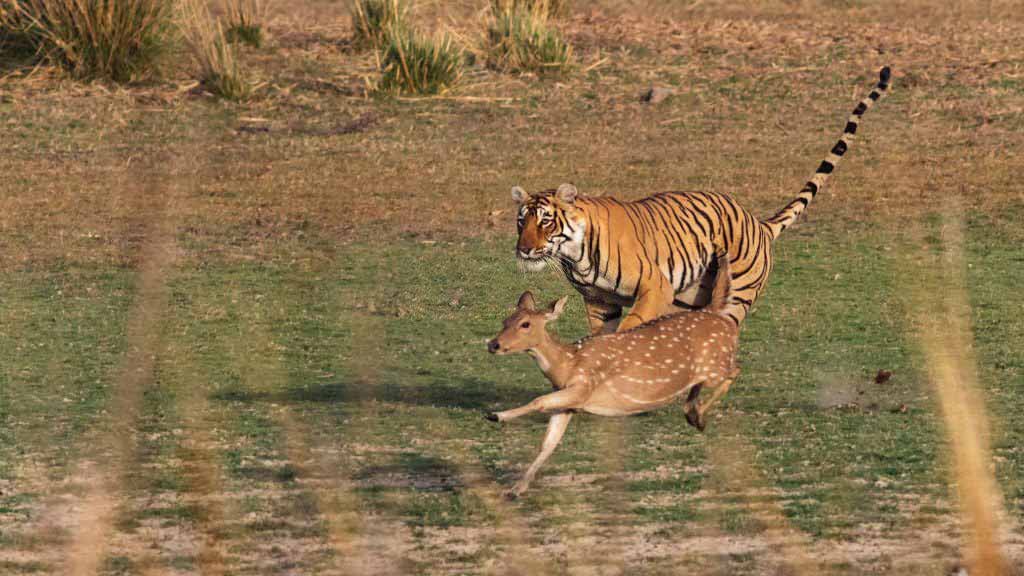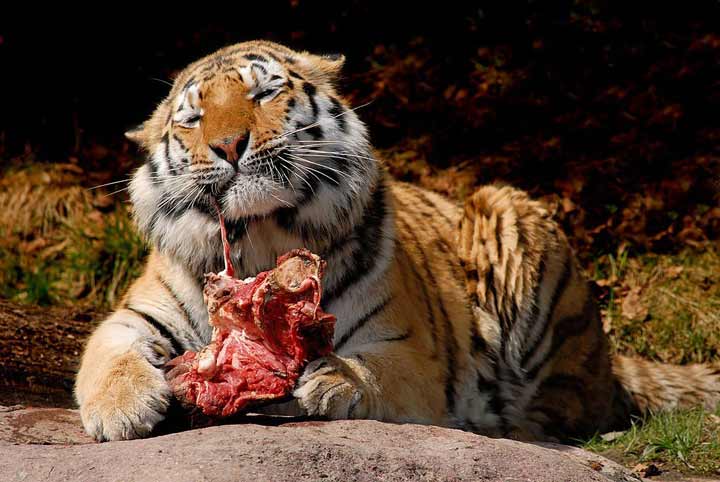Tigers, the largest of the big cats, are a symbol of strength, grace, and mystery. Their majestic appearance and unique behaviors have fascinated humans for centuries.
Let’s delve into the world of tigers and uncover some fun facts about these incredible creatures.
1. Biggest Cat

Male tigers can weigh up to 300 kilograms, making them the largest wild cats on Earth. Their immense size is not just for show; it’s a testament to their power and dominance in the wild, allowing them to take down large prey like buffalo and deer.
2. Longest Canines

Tigers have the longest canines among wild cats, measuring up to 10 centimeters. These formidable teeth are essential for gripping and tearing meat, showcasing the tiger’s predatory efficiency and ability to consume up to 40 kilograms of meat in one meal.
3. Milk Teeth
Like humans, tigers have milk teeth that fall out as they grow. These baby teeth are replaced by permanent ones, a process that reflects the tiger’s transition from a vulnerable cub to a formidable predator capable of hunting on its own.
4. A Deadly Swipe

A tiger’s paw is not something to be taken lightly. A single swipe can be fatal, thanks to their incredibly strong limbs and sharp claws. This deadly swipe is a stark reminder of the tiger’s hunting prowess and ability to take down prey much larger than itself.
5. Masters of the Night
Tigers are creatures of the night. They prefer to hunt under the cover of darkness, using their keen senses of sight, hearing, and smell to stalk and capture prey. This nocturnal behavior adds an air of mystery to their existence and enhances their success as predators.
6. Born Blind

Tiger cubs are born blind and rely entirely on their mother for survival for the first few weeks. This fragile beginning is a touching and vital stage in their life, highlighting the importance of family bonds and maternal care in the wild.
7. Water-Loving Cats
Unlike most cats, tigers love water. They are skilled swimmers and often indulge in playful splashing or serious hunting in the water. This affinity for water sets them apart from other big cats and allows them to hunt aquatic prey like fish and crocodiles.
8. Healing Saliva
While not exactly antiseptic, tiger saliva contains proteins that may aid in healing. This natural remedy is another example of the incredible adaptations found in the animal kingdom, helping them recover from minor injuries and infections.
9. Speed

Tigers can sprint up to 60 kilometers per hour, but only for short distances. This burst of speed, combined with their grace and agility, makes them formidable hunters, able to chase down and capture even the swiftest prey.
10. Stripes on Skin
A tiger’s stripes are not just on its fur; they’re on its skin too. These unique patterns are like fingerprints, giving each tiger a distinct identity. The stripes also serve as natural camouflage, helping them blend into their surroundings as they stalk their prey.
11. The Rough Tongue

A tiger’s tongue is covered with sharp projections called papillae that help in stripping meat from bones. This specialized tool is a marvel of natural engineering, perfectly suited to their carnivorous diet and allowing them to consume every part of their prey.
12. Gentle Giants
Despite their fearsome reputation, tigers have been observed allowing females and cubs to eat first. This unexpected gentleness adds depth to our understanding of these complex creatures and reflects a social hierarchy within their groups.
13. Urine Smells like Buttered Popcorn
Tiger urine smells like buttered popcorn to some. This unusual scent is a quirky and fascinating aspect of their biology, caused by a specific protein in their urine that breaks down into a compound similar to the aroma in popcorn.
14. Masters of Ambush

Tigers are experts at hunting by ambush. Their stripes serve as natural camouflage, allowing them to stalk their prey undetected. This stealthy approach, combined with their speed and strength, is key to their hunting success.
15. Solitary Wanderers
Tigers are solitary animals, often seen walking alone. This preference for solitude resonates with many of us and adds to their enigmatic allure. Their solitary nature also reflects their territorial behavior, with males patrolling vast areas to keep rivals at bay.
16. Diverse Diet

Tigers enjoy a diverse diet, ranging from deer to fish. This culinary adaptability helps them thrive in various habitats and reflects their opportunistic nature, allowing them to take advantage of whatever food sources are available.
17. The Art of Mimicry
Some tigers can mimic other animals’ calls to lure them in. This clever hunting tactic showcases their intelligence and adaptability, allowing them to deceive and capture unsuspecting prey.
18. Humans: Friends, Not Food
Tigers usually don’t view humans as prey. They tend to attack only when threatened, a behavior that underscores the importance of respecting their space and territory. Most human-tiger conflicts arise from habitat loss and human encroachment.
19. Adaptable Survivors

Tigers can live in various environmental conditions, from hot rainforests to frigid mountain regions. Their ability to adapt is a symbol of survival and resilience, allowing them to thrive in diverse ecosystems.
20. The Purring Mystery
Tigers can make a sound similar to purring, but it’s not quite the same as a domestic cat’s purr. This auditory enigma adds to the many mysteries surrounding these magnificent animals and reflects the complexity of their vocalizations.
21. Unique Stripes

Each tiger’s stripes are as unique as human fingerprints. No two tigers have the same pattern, and these stripes serve more than just aesthetic purposes.
They provide camouflage, helping tigers blend into their surroundings as they stalk their prey. The uniqueness of each tiger’s stripes is a beautiful reminder of individuality within the wild.
Conclusion
Tigers are a blend of strength, beauty, and complexity. From their impressive size to their unique stripes, every aspect of a tiger’s existence is filled with wonder and intrigue.
As we strive to understand and protect these incredible creatures, we are reminded of the wild’s splendor and our role in preserving it.




